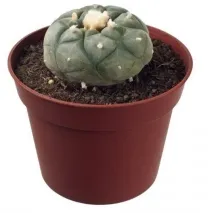
Explore the Magic of Mescaline during Cacti Week!
Imagine a journey that transcends the ordinary, where your mind explores realms of vivid visuals and profound insights. If you’re an adventurer at heart or a psychonaut eager for the next frontier, mescaline cacti might just be your ticket to an extraordinary experience. Known for their powerful hallucinogenic properties, these cacti have captivated human imagination and spirituality for centuries. At Avalon Magic Plants, we offer these magical cacti, alongside other psychedelics and wonders of nature, ready to ignite your next adventure!
Understanding the various mescaline cacti
Mescaline is a naturally occurring psychedelic compound found in certain cacti species. These include Peyote (Lophophora williamsii), San Pedro (Echinopsis pachanoi), and Peruvian Torch (Echinopsis peruviana). Each of these cacti has its own unique characteristics and history, but they all share the commonality of containing mescaline, which induces intense hallucinogenic effects. When ingested, mescaline binds to serotonin receptors in the brain, leading to altered perceptions, heightened emotions, and deep spiritual experiences.
Peyote: the sacred button cactus
Peyote (Lophophora williamsii) is arguably the most renowned mescaline cactus. This small, spineless cactus grows in the arid regions of Mexico and the southwestern United States. Peyote has been used for millennia by indigenous peoples, particularly in religious and healing ceremonies. Its significance is deeply rooted in the spiritual practices of the Native American Church, where it is considered a sacred sacrament.
Characteristics and potency
Peyote is distinctive for its small, button-like appearance and its greyish-green color. It grows low to the ground and often takes years to mature. Peyote contains a high concentration of mescaline, making it one of the most potent mescaline cacti. The experience of consuming Peyote can last anywhere from 10 to 12 hours, with users reporting vivid visual hallucinations, emotional breakthroughs, and profound spiritual insights.
Cultural significance
The cultural importance of Peyote cannot be overstated. It has been a cornerstone of spiritual and healing practices for indigenous cultures for thousands of years. The rituals involving Peyote often include chanting, drumming, and other ceremonial activities designed to guide participants through their journey. This spiritual context can greatly enhance the experience, providing a framework for understanding the visions and emotions that arise.
San Pedro: the Andean column
San Pedro (Echinopsis pachanoi) is a tall, columnar cactus native to the Andes mountains, primarily found in Peru and Ecuador. Unlike Peyote, San Pedro grows much more rapidly and can reach impressive heights of up to 20 feet. It has been used traditionally in Andean shamanic rituals for centuries, often in the context of healing and divination.
Characteristics and potency
San Pedro is identifiable by its tall, green columns adorned with clusters of spines. It contains mescaline, though typically in slightly lower concentrations than Peyote. However, San Pedro’s fast growth and relative ease of cultivation make it a popular choice among both traditional users and modern psychonauts. The effects of San Pedro can last between 8 to 14 hours and are often described as more gentle and gradual compared to Peyote. Users frequently experience a deep connection to nature, enhanced sensory perception, and spiritual clarity.
Shamanic traditions
In traditional Andean cultures, San Pedro is known as "Wachuma" or "Huachuma." Shamanic ceremonies involving San Pedro often take place at night and can include chanting, music, and guided meditations. The shaman, or healer, plays a crucial role in these ceremonies, helping participants navigate their experiences and interpret their visions. This guided approach helps ensure that the profound effects of San Pedro are integrated meaningfully into the participants’ lives.
Peruvian Torch: the fiery cousin
Peruvian Torch (Echinopsis peruviana) is closely related to San Pedro, both botanically and culturally. This cactus also hails from the high Andes of Peru and is known for its striking appearance and potent effects. While it shares many similarities with San Pedro, the Peruvian Torch is often regarded as having a slightly different, sometimes more intense, psychedelic profile.
Characteristics and potency
Peruvian Torch is characterized by its tall, ribbed columns and blue-green hue. It contains mescaline concentrations similar to San Pedro, though some users report a faster onset and a more intense initial experience. The effects can last from 8 to 12 hours, offering a journey filled with vivid visuals, deep emotional exploration, and heightened sensory awareness. The Peruvian Torch is favored by those looking for a robust and dynamic mescaline experience.
Cultural and spiritual use
Similar to San Pedro, the Peruvian Torch has been used in traditional Andean ceremonies for centuries. These rituals are designed to foster healing, spiritual growth, and connection to the divine. The ceremonies often take place in natural settings, which enhances the participant's sense of unity with the environment. The cactus’s powerful effects are believed to facilitate communication with spirits and the natural world, offering insights and guidance.
Which one to choose?
While all three cacti—Peyote, San Pedro, and Peruvian Torch—offer profound psychedelic experiences, there are notable differences in their potency, duration of effects, and cultural contexts. Peyote is highly potent with a long history of spiritual use among Native American tribes. San Pedro, less intense but more accessible, is deeply embedded in Andean shamanic traditions. The Peruvian Torch, similar to San Pedro, is known for its intense initial effects and is also a staple of Andean spirituality.
Choosing the right cactus for your journey
When deciding which mescaline cactus to explore, consider your experience level and the type of journey you seek. If you’re new to psychedelics, San Pedro might be a good starting point due to its more gradual onset and manageable intensity. For those seeking a more intense and profound experience, Peyote or Peruvian Torch could be the way to go. Regardless of your choice, it's essential to approach these powerful plants with respect and preparation.
Practical tips for consumption
- Preparation: Ensure you are in a safe, comfortable environment. A positive mindset is crucial for a beneficial experience.
- Dosage: Start with a lower dose to gauge your sensitivity. Mescaline’s effects can vary greatly between individuals.
- Tripsitter: Having a sober friend to support you can be invaluable, especially if it’s your first time.
- Integration: Take time to reflect on your experience afterward. Journaling or discussing your journey with others can help integrate the insights gained.
The chemistry behind mescaline
Mescaline is a phenethylamine, structurally similar to neurotransmitters like dopamine and norepinephrine. When ingested, it interacts with serotonin receptors in the brain, particularly the 5-HT2A receptor. This interaction leads to altered sensory perceptions, profound emotional states, and sometimes spiritual or mystical experiences. Mescaline typically takes 45 minutes to 2 hours to take effect, with the peak experience lasting several hours.
The journey of mescaline in the brain
Once ingested, mescaline undergoes a series of processes in the body. It is absorbed through the gastrointestinal tract and then distributed throughout the body, including the brain. Here, it mimics the action of serotonin, a neurotransmitter involved in mood regulation, sensory perception, and cognition. By binding to serotonin receptors, mescaline enhances sensory input, amplifies emotions, and can create a sense of unity with the surroundings.
The general effects of mescaline are multifaceted, encompassing both sensory and cognitive domains. After ingestion, the onset of mescaline's effects typically begins within 45 minutes to two hours, with the peak experience lasting several hours and the entire journey spanning up to 12 hours. Users often describe an overwhelming sense of euphoria and a heightened appreciation for their surroundings. This is accompanied by a profound sense of interconnectedness with nature and the universe, often described as a spiritual awakening or enlightenment.
The perceptual changes are accompanied by emotional shifts, where users might feel an intense sense of empathy, joy, or even sorrow as they navigate their inner landscapes. Time perception is usually distorted, with minutes feeling like hours or vice versa, creating a timeless experience. The introspective nature of mescaline allows individuals to explore their thoughts and emotions in great depth, often leading to personal insights and emotional breakthroughs. However, the experience is not without its challenges; some users might encounter difficult emotions or anxiety, especially if taken in an uncomfortable or unsafe environment. Therefore, it's crucial to approach mescaline with respect and preparation, ensuring a supportive setting and mindset to navigate its powerful effects.
Try some yourself!
Mescaline cacti offer a unique and deeply profound psychedelic experience. Whether you choose Peyote, San Pedro, or Peruvian Torch, each cactus provides its own distinct journey filled with vivid visuals, emotional breakthroughs, and spiritual insights. Understanding the differences between these cacti and their cultural significance can enhance your appreciation and respect for these powerful plants.
At Avalon Magic Plants, we are dedicated to providing high-quality mescaline cacti and other psychedelics to support your explorations. Whether you are a seasoned psychonaut or a curious newcomer, we offer the products and information you need to embark on your psychedelic journey safely and meaningfully. So why wait? Dive into the fascinating world of mescaline cacti and discover what these extraordinary plants have to offer. Your next adventure awaits!










